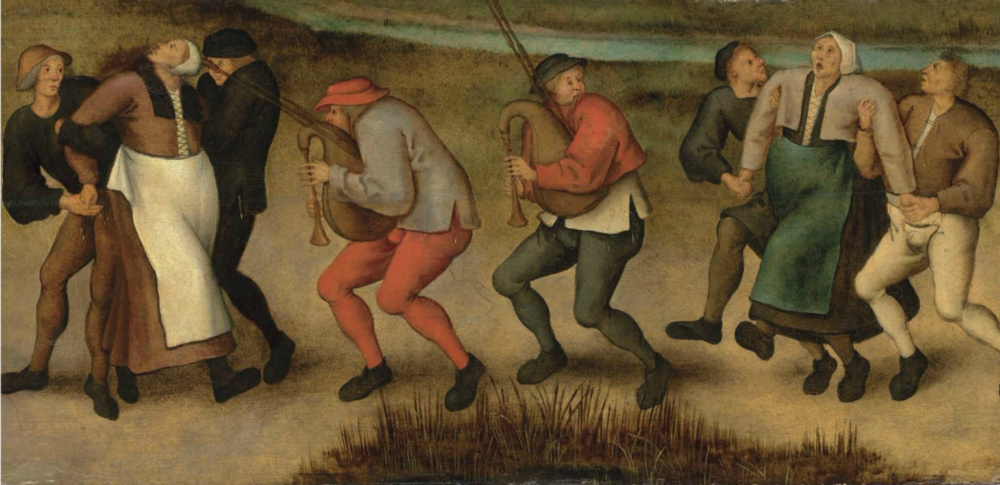The Strange but True Story of the Dancing Plague

Frau Troffea seemed normal enough. She washed dishes, hung the laundry, and did a good bit of gossiping just like every other woman in Strasbourg in 1518. That is until the night of July 14th. Maybe it was something she ate, maybe she was overtired from doing laundry, no one will ever really know. It started with a tap of the toe, then a gentle sway of the hips. Soon she was in a full-fledged dance. Without a band, without a singer, without even a walkman. Out into the cobbled streets she went and those feet started flying. Clickity clackity clackity went her shoes against the stones. She danced while her neighbors made dinner, she danced when the children went to bed. She was still dancing when the sun went down. Finally, she collapsed from exhaustion.
With the crow of the rooster and the rising of the sun, however, the Frau was dancing again. For about six days she danced. People from all over the town came to see the strange sight. “She seemed like such a normal woman,” they said. “Who would have thought she would end up the dancing queen!”
“It’s a curse!” The authorities yelled and sent her to the shrine of Saint Vitus to beg forgiveness. “That’s that,” they said and congratulated themselves on a job well done. But when they turned around what did they see? More dancers–then more and more until by the end of the month 400 people were crazy footloose. it was an epidemic. No, it was worse than that. It was a plague—A plague of dancing.
Shut up and dance
“Obviously a disease from overheated blood,” said the doctors who were called in to investigate. In their expert wisdom, they decided the best way to end the plague was to encourage more dancing.
“We’ll call it the Safety Dance!” the declared and called in workers to build a big stage.
Drums, fiddles, pipes, and horns were brought in along with healthy dancers to keep the party going. Not surprisingly the cure only made things worse. Heart attacks, strokes, and just plain exhaustion got the better of many of the dancers, causing a death rate of about 15 people a day. Thinking the failure of the all-out dancing policy wasn’t going to get them many votes, the politicians made a 360 turn.
“Music and Dancing are hereby outlawed!” the shouted. “Not a whistle, not a hum—not even a long melodious burp will be tolerated until September. (That is of course unless you’re an honorable person wishing to dance at a wedding or other such celebration. That’s ok—but no tambourines or drums, please.)”
As for those who still couldn’t stop dancing, they were headed for a vacation at the shrine of St. Vitus. It seems Frau Troffea had faired well on her visit. Everyone hoped the saint would help the others as well. Of course, the priests weren’t surprised. They said from the start the thing was demonic, and who’s to say they were wrong?
Once the afflicted arrived at the shrine, they were placed under a statue of the saint, sprinkled with holy water, and anointed with oil. Miraculously, when the process was completed the patients were cured. Recover rates were so well, the rest of the towns oppressed were sent and the plague was finally brought to an end.
Save the last dance for me
This wasn’t the first attack of the dancing plague, although it was one of the worst. There were around 10 occurrences, the first being in 1374 along the Rhine and Moselle rivers. Strasburg saw its first case in 1418. Day and night they danced through the streets, their steps accompanied by the music of a group of bagpipes. In mild cases, the patient might suffer long bouts of laughter and “involuntary fits of intoxicating joy.” The worst of the afflicted were said to look possessed. They would scream, and foam at the mouth oblivious to those around them. Finally, they fell to the ground senseless.
On looking back at the event, the Swiss physician Paracelsus came up with a very scientific answer to what had caused the plague.
Spite.
Frau Troffea was fed up with her husband and wanted to find a way to really stick it to him. She figured embarrassment was the key to his destruction. Knowing how he hated her singing, she jumped about crooning loudly, all the while pretending the thing was a sickness. Once she started other wives took up the idea and joined in. Chorea lasciva he called it. A mania caused by unruly desires. Of course, he came up with some other causes too, not everyone could be classified as a vengeance-seeking wife after all.
But what was it, really?
Encephalitis, epilepsy, and typhus were suggestions given over the years. Ergot poisoning was a pretty popular diagnosis for a while. Popular, but infeasible. Ergot, a mold that grows on rye, causes similar symptoms such as twitching and jerking. However, it also restricts blood flow which would make dancing difficult. Additionally, the people of Alsace were aware of the dangers of ergot poisoning and certainly would have known it had they seen it.
It seems the best answer researchers can come up with these days is mass hysteria. The people already believed St. Vitus would curse sinners by forcing them to dance, and they were quick to assume he was the cause of their affliction.
On top of that, the people of Strausburg were highly stressed thanks to recent social conflicts, inflation, crop failures, and other diseases. 1517 had been a bad year, leaving hospitals, shelters, and orphanages overflowing. The stress and trauma added to the preconceived idea of a saint doling out punishment may have been enough to push people over an emotional edge.
Certainly, throwing the healthy in with the sick added to the hysteria. Thanks to the power of suggestion, witnessing the behavior patterns of the afflicted could have been enough to drag the healthy onlookers into the dance.“Men, it has been well said, think in herds; it will be seen that they go mad in herds, while they only recover their senses slowly, and one by one.” said author Charles Mackay in 1841. It’s possible that the statement applies here. However, in the end, no one really knows what happened. There’s no concrete evidence to support any theory.
Notes and Sources:
For you youngin’s, a Walkman was a portable cassette player that was popular in the ’80s. Don’t know what a cassette is either? Google it.
https://archive.org/details/00338041.9352.emory.edu/page/n109
https://www.thelancet.com/journals/lancet/article/PIIS014067360960386X/fulltext
https://www.history.com/news/what-was-the-dancing-plague-of-1518
http://www.bbc.com/future/story/20161028-the-town-the-nearly-danced-itself-to-death
https://publicdomainreview.org/essay/the-dancing-plague-of-1518
https://www.theguardian.com/stage/2018/jul/05/bizarre-dance-epidemic-of-summer-1518-strasbourg
https://www.history.com/news/what-was-the-dancing-plague-of-1518
https://www.thelancet.com/journals/lancet/article/PIIS014067360960386X/fulltext
https://www.historicalblindness.com/blogandpodcast//the-dancing-plague


Leave A Comment